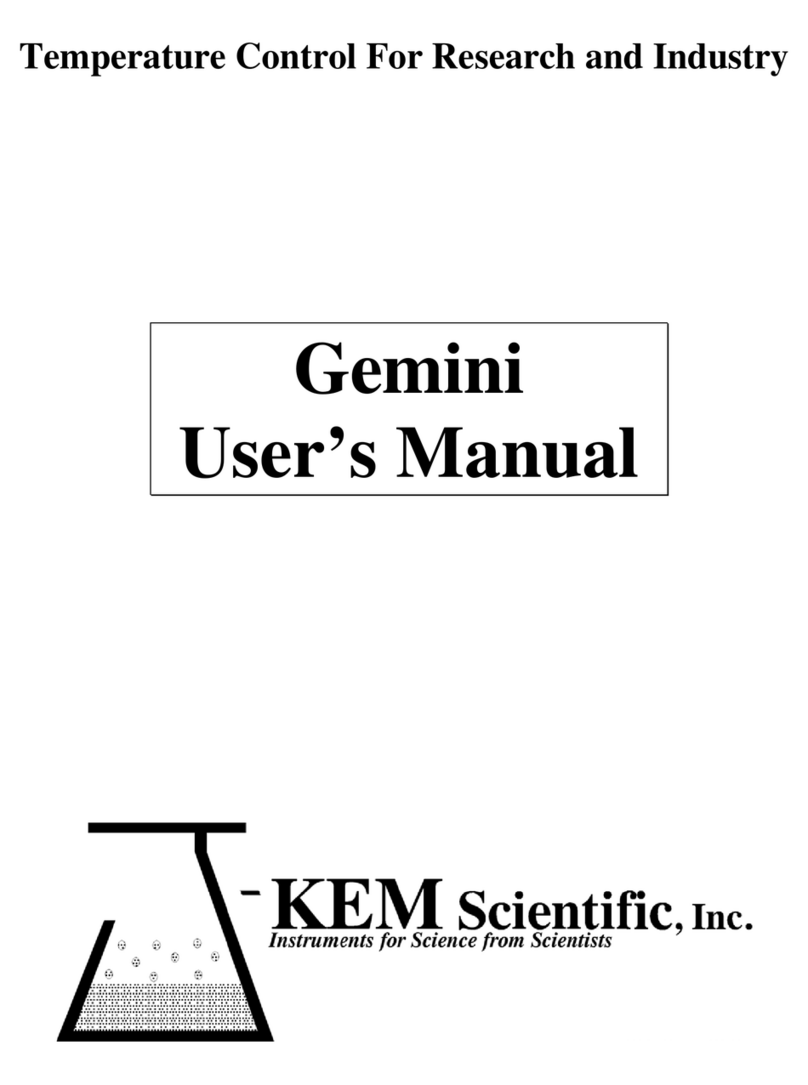
Section 1: Quick Operating Instructions
The four steps below are the basics of using your temperature controller. The User’s Manual is a reference that explains the
controller more fully as well as some of its more sophisticated features. It’s recommended that new users unfamiliar with
process controllers read the entire manual carefully. The controller is preprogrammed for use with heating mantles fitted
to round bottomed flasks running “typical” organic reactions (i.e., non-polymeric reactions in solvents such as THF,
toluene, DMF, etc.). If the controller is used with this type of reaction, the 3 steps below will help you get started.
To use heaters other than heating mantles: See Section 2.
Do not use the controller to heat oil baths: See Section 3.2 & Appendix I.
For polymer synthesis, atypical, expensive, or safety critical reactions: See Appendix II.
NOTE: The Gemini has 2 completely separate temperature controller in a single cabinet labeled “Channel 1” and
“Channel 2”. Any change or adjustment made to Channel 1 will have no affect on Channel 2 and visa versa. The
instructions below apply to each channel individually.
1Place the thermocouple in the solution being heated. Place at least the first 1/4” of the
thermocouple directly in the solution being heated. Thermocouples can be bent without harming them. If you’re
heating a corrosive liquid, use a Teflon coated thermocouple. If you are heating a sealed reaction, see Section 4.2.
2Set the power level
switch to the volume of
solution being heated (not
the size of the flask being used).
Adjust the power
Output Power Level
1 -
10
ml
10 -
100
ml
50 -
500
ml
300
ml
- 2
L
>2
L
Heat
Off
Channel 1
Channel 2
TIP: Because the
power switch acts like
a variac, if the reaction
is heating too slowly
or you need more
power
level for the channel being used.
The power level switch can be
thought of as a solid state variac.
Volume ranges are printed above
this switch as a guide to select the
correct power level since it’s easier
to guess the volume being heated
than the appropriate “percent
power” to apply to a heater. ‘Heat
Off’ turns off the heater so the
controller displays temperature
only. Section 3.6 should be read by
all new users.
A power is equivalent to
setting of..... a variac setting of:
1 10 ml 3%
10 100 ml 10%
50 500 ml 25%
300 ml 2 L 50%
> 2 L 100%
(e.g., heating to high temperatures), give
the heater more power by turning the
power level up one setting. If the
reaction needs less power than
normal(e.g., heating to low temperatures
(<60o C) or the temperature overshoots
the set point excessively, turn the power
down one setting. DO NOT set the
power switch on a setting too high
initially to heat the reaction quickly and
then lower it to the correct setting, this
degrades heating performance.
3Enter the setpoint (i.e., the desired temperature). Hold in
the ❊button and simultaneously press the key to increase or the▲ ▼
key to decrease the setpoint. The setpoint can be seen at anytime by
holding in the ❊button, the setpoint appears as a blinking number in
the display.
4Set the timer.
The timer turns the heating
outlet OFF or ON depending
on the position of the timer
switch and whether any time is
present in the display
5





























